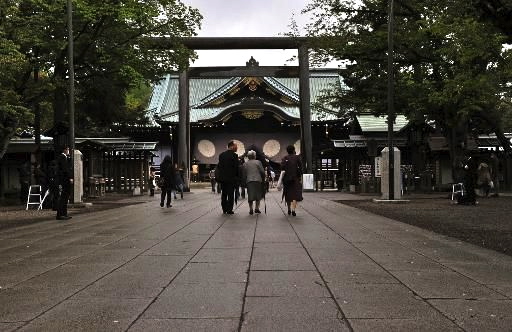The divisive nature of Yasukuni Jinja is highlighted each year on the anniversary of Japan’s defeat in WW2, when the shrine acts as a symbolic rallying point for extremists. An article in The Japan Times below illustrates to what extent political issues dominate what apologists like to pretend is a purely religious matter. The shrine has been made into a rallying point for reactionaries who wish to reinstigate State Shinto, and there are established alternatives for paying respects to the war dead such as Chidorigafuchi. (For more about Chidorigafuchi, click here. For a visit by US politicians Kerry and Hagel, see here. For the emperor’s take on Yasukuni, see here.)
******************************************
Anniversary of WWII surrender met with varied reaction
BY AYAKO MIE AND KAZUAKI NAGATA AUG 15, 2014 Japan Times
As Japan marked the 69th anniversary of its surrender in World War II on Friday, people on the streets of Tokyo showed mixed reactions. Right-leaning visitors to Yasukuni Shrine found a new cause in their movement, while the day evoked memories of wartime suffering among older residents. For many young people, however, the anniversary meant little more than a reminder of a day from the distant past.
 Right-leaning activists around Yasukuni Shrine demanded the government embrace more nationalistic policies, such as revising the pacifist Constitution. They also called for recanting the so-called Kono Statement from 1993, which admitted the Japanese army and other authorities were at times involved in forcibly recruiting women, mostly from the Korean Peninsula, to provide sex to Japanese soldiers before and during World War II.
Right-leaning activists around Yasukuni Shrine demanded the government embrace more nationalistic policies, such as revising the pacifist Constitution. They also called for recanting the so-called Kono Statement from 1993, which admitted the Japanese army and other authorities were at times involved in forcibly recruiting women, mostly from the Korean Peninsula, to provide sex to Japanese soldiers before and during World War II.
“We see more people are signing a petition this year compared to last year,” said Takao Ishihara, president of the Japan Society for History Textbook Reform, which was organizing a campaign to present a more nationalistic view of the past in school texts. “This is a war for the correct understanding of history.”
The group said that their movement is gaining momentum, especially after the Asahi Shimbun, which is generally seen as a liberal daily and often becomes the target of conservatives, earlier this month admitted there were errors in its past “comfort women” stories.
Asahi retracted all the stories it had published, stretching back decades, that quoted a Japanese man who claimed he kidnapped about 200 Korean women and forced them to work at wartime Japanese military brothels.
The Abe administration in June also said the accounts of 16 former South Korean comfort women, on which the Kono Statement was based, were not backed up by evidence. The government also said Japanese and South Korean officials consulted one another on the wording of the statement before it was issued by then Chief Cabinet Secretary Yohei Kono.
Meanwhile, hundreds of people marched to Yasukuni Shrine, waving Japanese flags and claiming the war was defensive in nature and that Japan never invaded any Asian countries. The march was organized by a group headed by Toshio Tamogami, a former Air Self-Defense Force general.
“It was not Article 9 of the Constitution that maintained Japan’s postwar peace. Thanks to the mighty Japanese soldiers who fought the war, China and Russia were too afraid to attack Japan,” said one participant in the march who only identified himself as Murata. “We should thank the soldiers.”
Tensions escalated in the afternoon when a group denouncing the emperor system marched near Yasukuni and had a close encounter with the Zaitokukai rightist group. Members of Zaitokukai yelled, “Go back home, you Koreans,” throwing PET bottles into the crowd of left-leaning activists who were part of Hantenren, the group opposed to the emperor system.

It’s always controversial